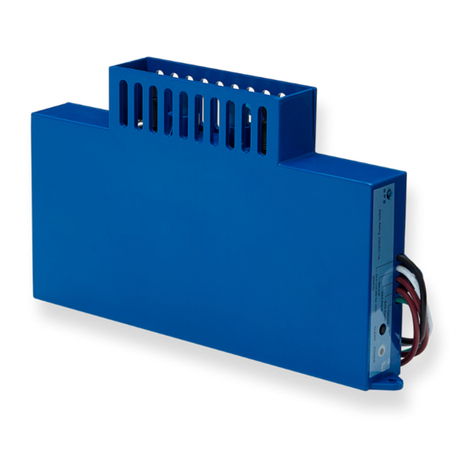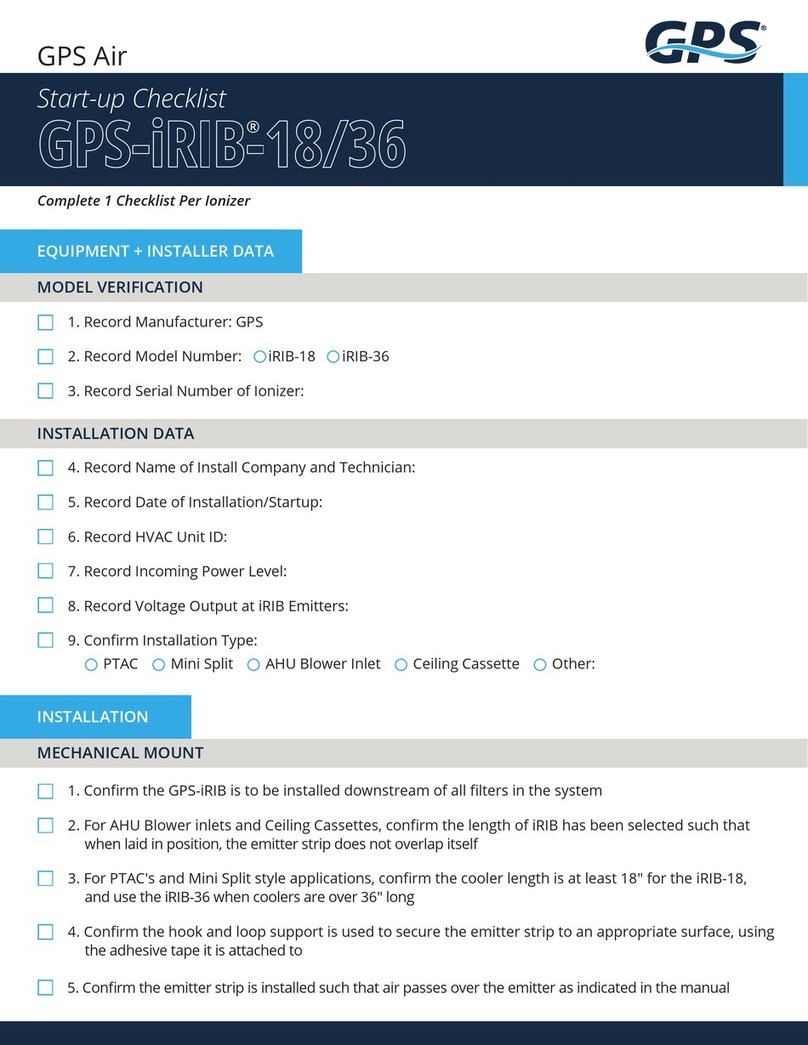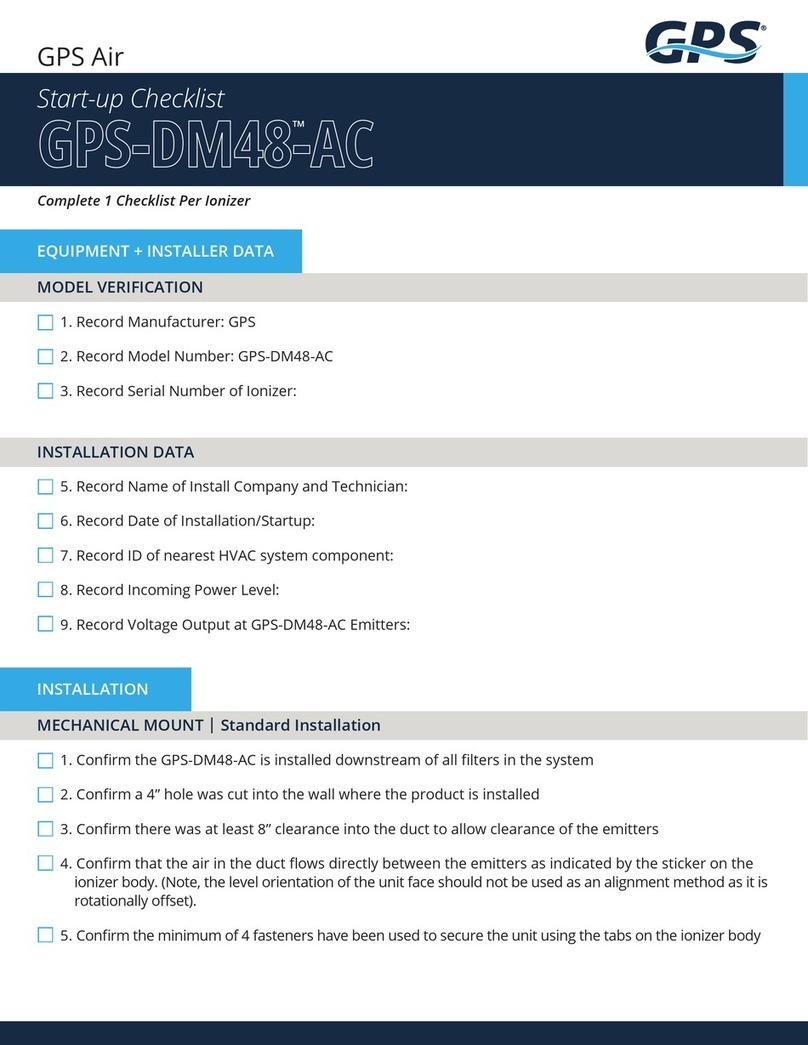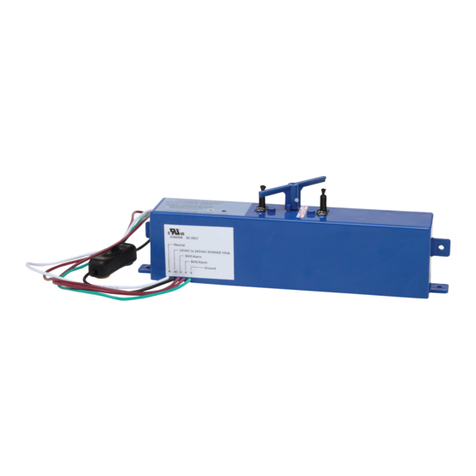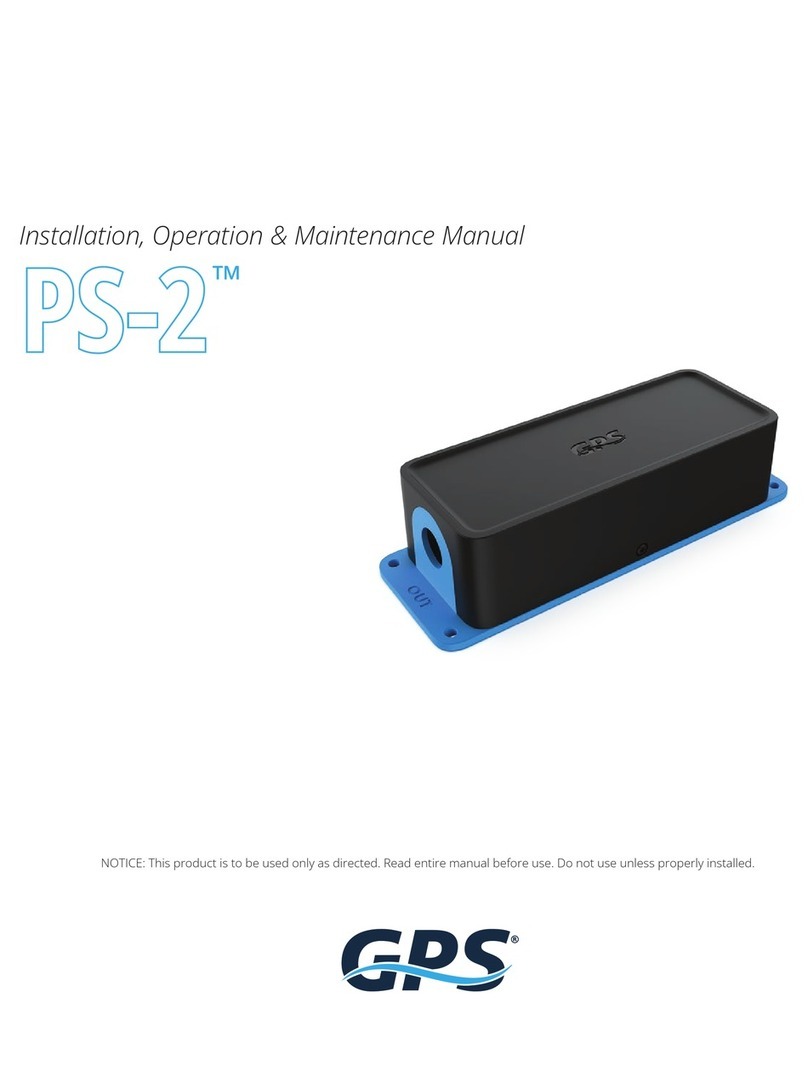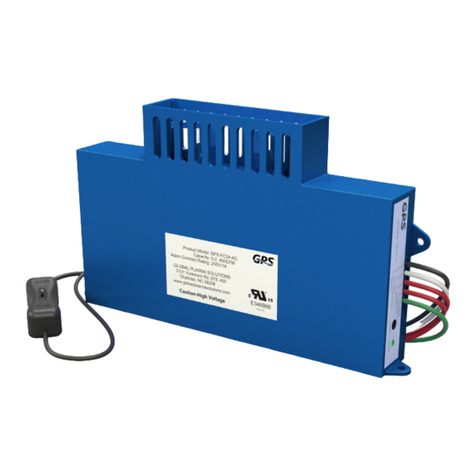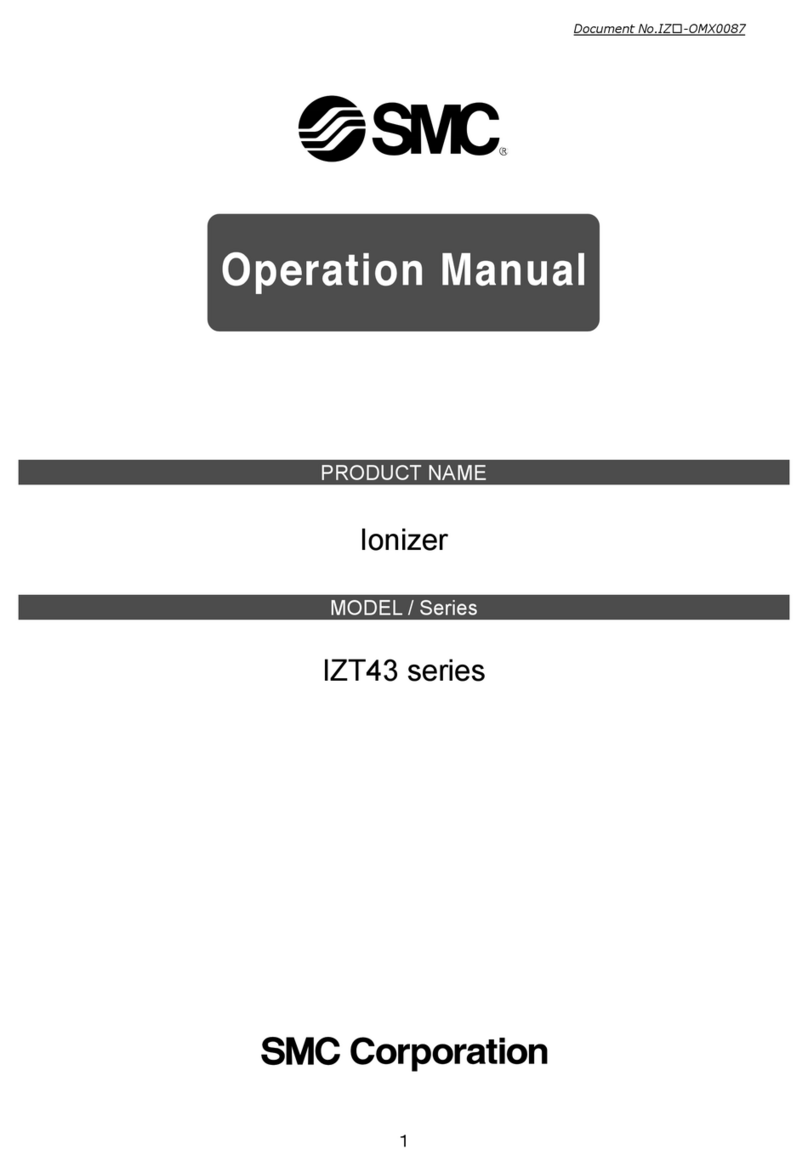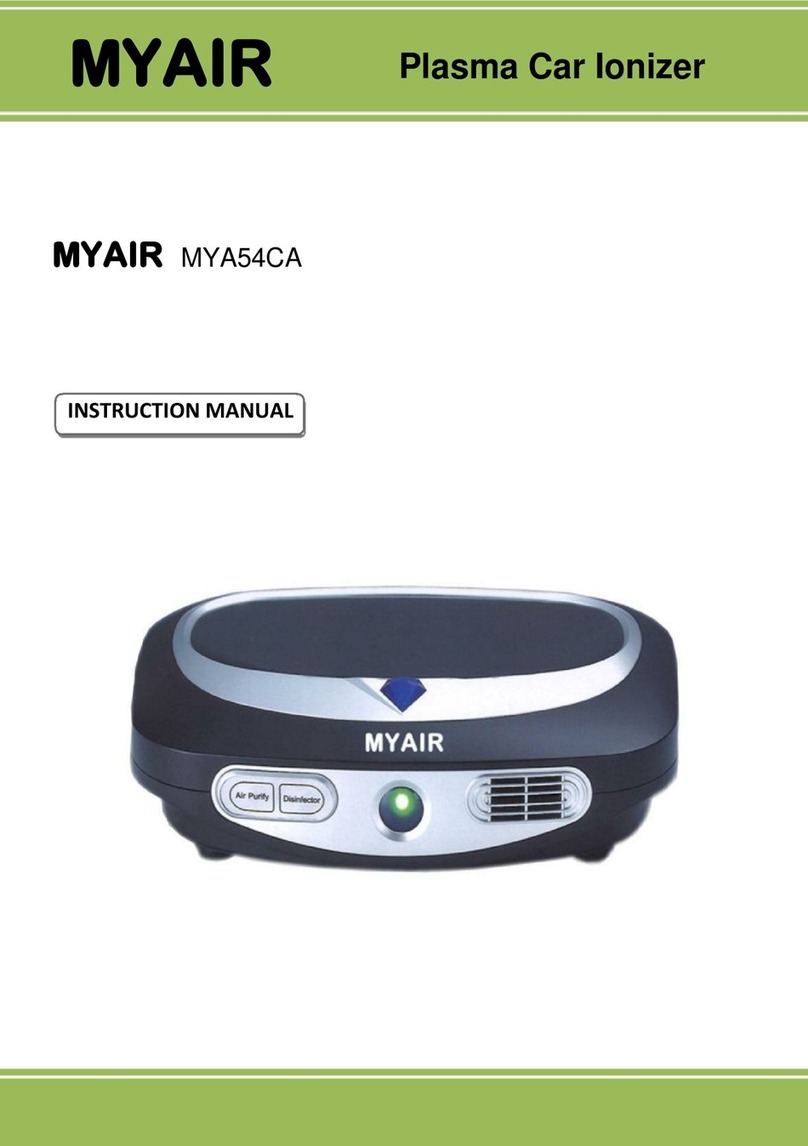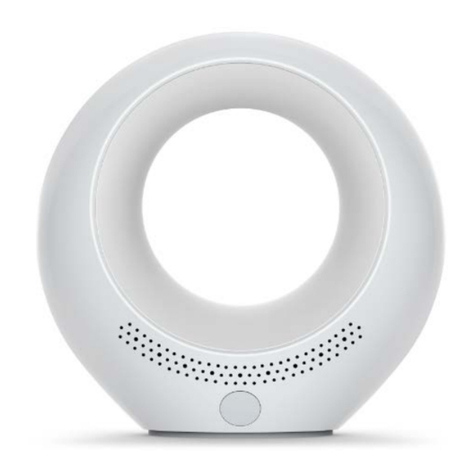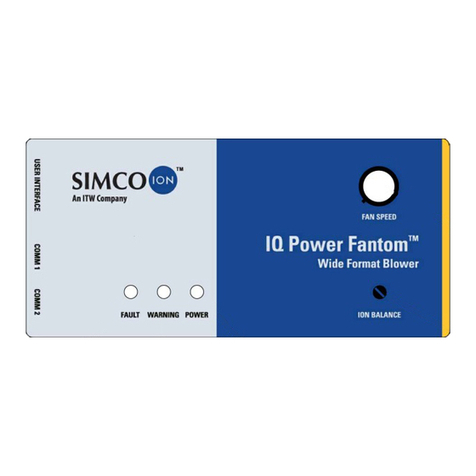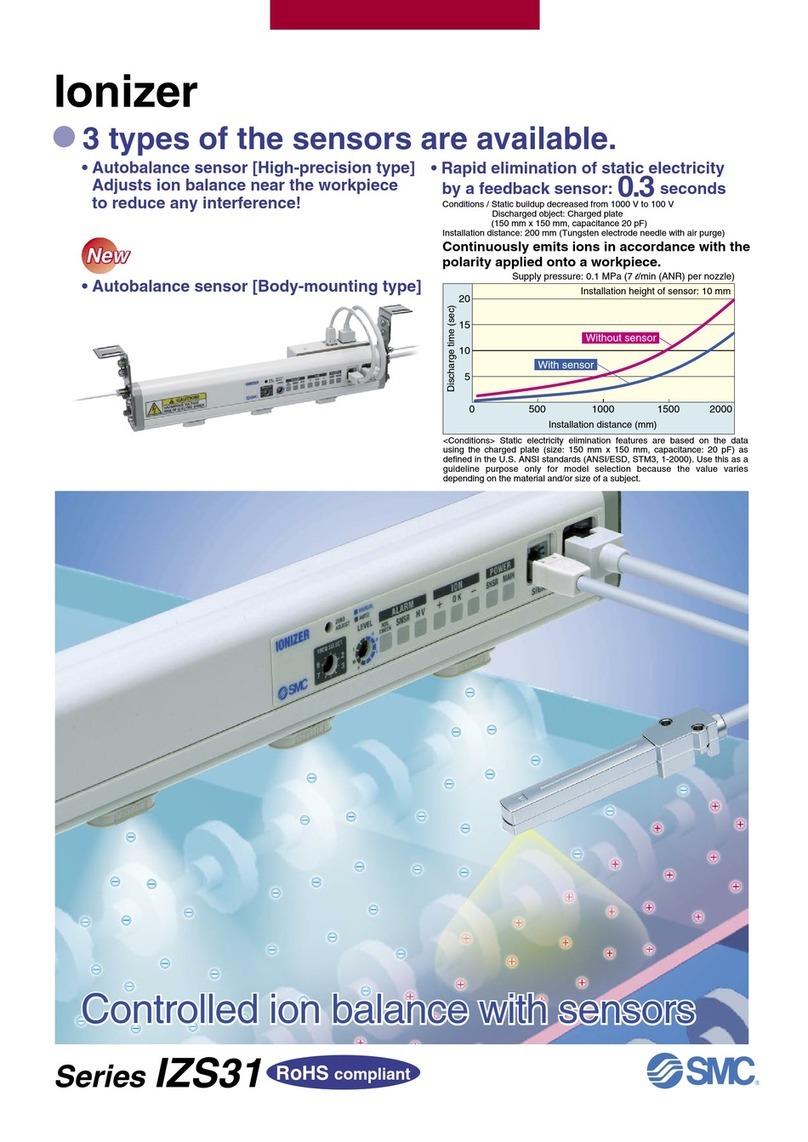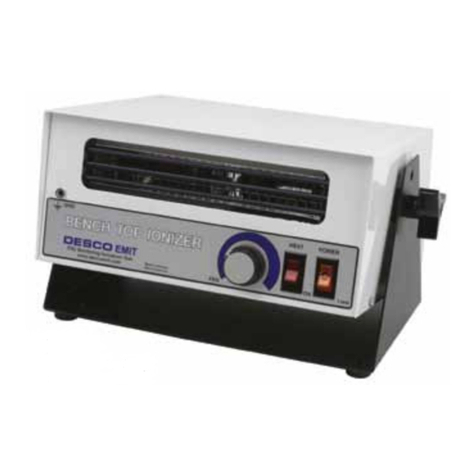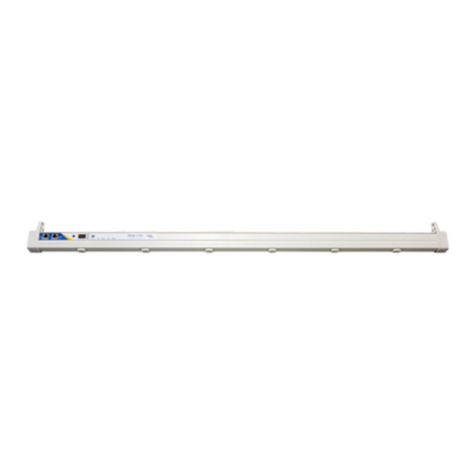GPS GPS-iMOD Instruction manual

www.globalplasmasolutions.com
Installation, Operation & Maintenance Manual
GPS-iMOD®
NOTICE: This product is to be used only as directed. Read entire manual before use. Do not use unless properly installed.

www.globalplasmasolutions.com
Thank you for purchasing a GPS-iMOD®air ionization system from Global Plasma Solutions (GPS®).
Hardware Provided by GPS
Before you start, conrm the contents of your shipment contains all the parts ordered. Each GPS-iMOD system will
consist of the following components:
1. GPS-iMOD 15-watt power supply with multi-voltage input: (24VAC/0.5A; 120VAC/0.12A; 208-240VAC/0.065A).
2. GPS-iMOD 6’ or 15’ exible high voltage cable with connectors and rst electrode on the bar already
attached. More than 1 high voltage cable may be provided based on the application and cooling coil
dimensions.
3. GPS-iMOD 6-inch modular sections provided per quantities ordered to achieve overall desired ionization bar
length.
4. End cap for each iMOD assembly bar. End cap inserts into the last modular section of the bar to prevent
contamination.
5. A minimum of 2 mounting magnets per bar for securing the GPS-iMOD to the cooling coil inlet on the
downstream side of the lter rack. Magnet quantity provided will increase based on overall bar length. Refer
to iMod Mounting section for recommended magnet spacing.
6. Nylon screws and nuts for securing magnets to the front or back of the iMOD sections and metal screws
for securing magnets to the top of the iMOD sections where the bar can be mounted to the ceiling of an air
handler.
Hardware Requried by Others
1. Self-tapping sheet metal screws. Care should be taken when selecting self tapping screws to avoid
penetrating the cooling coil.
2. Electric wiring, junction box or receptacle to provide power to the GPS-iMOD power supply, optional door
switch, optional remote mounted ion detector sensor, or optional NEMA enclosure for power supply. Note:
optional items may be included based on the items quoted or provided in the purchase order.
Installation Location
The optimal location to mount the GPS-iMOD is between the particulate lter and immediately upstream of the cooling
coil.
CAUTION: MAKE SURE POWER IS DISCONNECTED TO THE HVAC EQUIPMENT BEFORE INSTALLATION
!

www.globalplasmasolutions.com
Figure 1 Figure 2
Threaded
Post
Smooth
Post
Threaded
Receiver
Smooth
Receiver
Mechanical Installation
For standard applications, there should be a quantity of 1 GPS-iMOD bar assembly on each coil up to 60 inches in height.
The GPS-iMOD bar(s) should be spaced a maximum of 60 inches apart for appropriate ionization coverage on the coils.
iMOD bar shall cover the entire nned length of coil to the nearest 6” without exceeding the length of the coil. (see
FIGURE 13).
1. Determine which style of GPS-iMOD is being installed.
i. If using the screw-type iMOD, go to Step 1A (Refer to FIGURE 1 for GPS-iMOD screw-type with threaded
post).
ii. If using the snap-type iMOD, go to Step 1B (Refer to FIGURE 2 for GPS-iMOD snap-type without threads).
Step 1A – Assembly of screw-type GPS-iMOD
Once the mounting location has been veried, assemble the modular sections by inserting the male threaded post into
the female receiver of the rst modular section already attached to the powerhead (see FIGURE 3) and tighten until the
modular housings are securely butted to each other. See FIGURE 4 below for correct assembly alignment. Please note,
it should take 3-4 complete revolutions to assemble properly. Continue process until all modules are assembled to the
desired length of the bar.
Not all the bars will screw together and line up with the brushes pointing in the same direction without using excessive
force that could damage the module. Below are directions to assemble the bars to ensure alignment.
iMOD ALIGNMENT
When the sections do not align properly after they have
been securely adjusted, as shown in FIGURE 5, disassemble
the section and place nylon spacer(s) provided by GPS
between the two sections as shown in FIGURE 6. Use
several if needed.

www.globalplasmasolutions.com
Once the spacer is placed over the male end of the device, twist the sections together until the parts are snug, and
the carbon ber brushes are pointing in the same direction, as shown in FIGURE 4A. Please note, once the bars are
assembled, there should be no “wobble” between the sections. Proceed to 2.
Step 1B – Assembly of snap-type GPS-iMOD
Once the mounting location has been veried, assemble the modular sections by inserting the post-end of the iMOD
into the receiver-end of the rst modular section already attached to the powerhead (see FIGURE 7). Attach iMOD
sections, making sure they are properly aligned as shown in FIGURE 8. Attach the iMOD sections by using a rubber
mallet and carefully tapping with enough force to cause the modular sections to “snap” together (see FIGURE 9). Set
iMOD on hard, at surface when assembling with mallet. Hold iMOD rmly while tapping with hammer to avoid slipping.
Do not hold iMOD between sections while assembling to avoid pinching.
CAUTION: Once iMOD sections are snapped together, they cannot be disassembled without breaking o the end piece.
Continue assembling the modular sections until you reach the needed length for the coil. After assembling the
rst 8 iMOD sections, lay the assembly on oor with the powerhead rmly butted against a rigid wall. See FIGURE
10. Continue to add iMOD sections until you reach the required length of the assembly. Proceed to 2.
2. Once the last iMOD section is added, push the nylon end cap into the receiver end of the last iMOD section. It
will “snap” into place with proper pressure. Refer to FIGURE 11.
3. Verify all iMod sections are engaged and the end cap is installed prior to mounting in the air handler.
!

www.globalplasmasolutions.com
iMOD Mounting
The included magnets can be used as a spacer even when installing on non-magnetic surfaces. Care should be taken
when selecting self tapping screws to avoid penetrating the cooling coil.
4. The GPS-iMOD modular sections can be mounted using the included magnets and hardware, or they can be
mounted using sheet metal screws (not provided) through the integral molded brackets. There should be
at least one magnet mounted on each end of the bar assembly and depending on length of bar, magnets
should be mounted on every third section (roughly 18” spacing between magnets). Refer to FIGURE 12
for examples of top or side magnet mount installations. Nylon screws and nuts are provided by GPS for
mounting the magnets to the front or back of the bar.
5. When mounting the GPS-iMOD, the bottom of the GPS-iMOD should be level with top of the nned surface
area of the coil as shown in FIGURE 13, with the carbon ber brushes pointing towards the oor.
NOTE: The clearance between the mounting surface and the side wall of the bar should be between 1/2” and 1/8”.
Failure to do may result in low ion density and poor performance.
Keep all metal away from carbon ber brushes. The ionization bar should always be mounted on the air-
entering side of the cooling coil. Mounting the bar on the leaving side of the coil (drain pan and wet side) will
not keep the coil clean. The GPS-iMOD (SCREW TYPE ONLY) powerhead may be rotated to provide the best
power cord routing based on the installation. Refer to FIGURE 14. When more than one bar is required per
coil, mount the second bar half-way down the coil with the needles pointing towards the oor.
Do not cut or alter high voltage cable. Use grommets for any holes or protrusions. High voltage wires should be
routed so no bend is less than a 3” bend radius (6” diameter for 180° high voltage cable routing).
NOTE: The installing contractor will need to provide a piece of metal angle across the face of the coil to attach the
GPS-iMOD if the coil nned surface area is over 3 feet wide.

www.globalplasmasolutions.com
Connection of GPS-iMOD bars to Power Supply
WARNING – The coiling or bundling of high voltage (HV) cables may cause added voltage drop and decreased ion output from
the iMod. Installations where the cable(s) are touching in multiple locations will experience reduced output and lifespan.
Please follow appropriate routing of high voltage (HV) cables as indicated below:
DO NOT CUT OR ALTER HIGH VOLTAGE CABLES. Cables 15ft long can be ordered if additional length is required. DO
NOT coil, bunch, or loop the cable up so that it comes in contact with itself. To reduce slack in the cable, create long
sweeping “S” shapes, like switchbacks in a road. High voltage cable should be routed with soft bends only such as
creating long sweeping “S” shapes. Minimum bend radius is 3”. Secure the cable(s) so they will not interfere with or be
damaged by equipment or personnel.
NOTE: When securing high voltage cable to a conductive surface, 2” standos shall be used to prevent high voltage cables from
contacting surface.

www.globalplasmasolutions.com
Power Supply Installation and Wiring
WARNING – DO NOT CONNECT POWER UNTIL VOLTAGE SELECTOR SWITCH INSIDE HOUSING IS CONFIRMED TO BE IN THE
CORRECT POSITION FOR THE PRIMARY POWER BEING APPLIED (See FIGURE 15).
The GPS-iMOD system requires a total of 15 watts to power up to 4 GPS-iMODs at any length. The power supply will
accept 24VAC, 115VAC or 208-240VAC at 50HZ or 60HZ. CAUTION!! The power supply has an internal voltage selector
switch set to 115VAC from the factory, as shown in FIGURE 15. If 24VAC or 208-240VAC is required, move the selector
switch to the proper position as shown on the circuit board or inside cover of the power supply lid. DO NOT APPLY
POWER until the switch position matches the power supplied. Based on voltage input or local codes, the 3-prong
plug may be cut o and the three wires are as follow: White = Neural, Black = 24V, 110V or 208-240V (based on switch
position) and Green = Ground. THE FACTORY ATTACHED WHITE POWER CORD MUST BE RETAINED WHERE IT
ENTERS THE iMOD POWER SUPPLY HOUSING. REMOVING THIS POWER CORD WILL VOID THE WARRANTY.
Follow all local and national electrical and building codes.
NOTE: The power supply must be grounded for all input voltages. If connecting to 24VAC power, the green grounding wire
or green grounding lug on the power supply housing must be connected to ground. A grounded common will not suce as
adequate power supply grounding.
1. The power supply may be mounted to the internal or external wall of the air handler.
2. Find a location within reach of the high voltage cable extending from the GPS-iMOD. Remove the 4 screws
securing the lid of the power supply.
3. Mount the power supply to the wall using sheet metal screws through the mounting tabs on the power
supply.
4. One HV port in the high voltage (HV) section will be left open for attachment of the HV supply wire. Refer
to FIGURE 16. Based on the jobsite specic wiring route, access to the right, left or top side may be desired.
Remove the plug from the port desired and ll the port not used with the spare plug. DO NOT RUN
HIGH VOLTAGE INPUT WIRES THROUGH THE CONTROL PORTS AND DO NOT RUN CONTROL WIRING
THROUGH HIGH VOLTAGE (HV) PORTS! REFER TO FIGURE 16.
5. Remove the top nut from the HV screw (FIGURE 17). DO NOT REMOVE THE BOTTOM NUT! Remove the plastic
nut (FIGURE 18) from the end of the high voltage cable. Next, push the HV wire through the desired port and
place the plastic nut back over the HV cable. Place the electrical eye connector over the HV screw and tighten
down the top nut to secure. If there are multiple bars connected, place all electrical eye connectors under the
top nut prior to tightening. Push the HV connector into the HV port and tighten the plastic nut to secure in
place (FIGURE 19). Once all connections are made, replace lid or proceed to connect the control wiring.

www.globalplasmasolutions.com
Connection to BMS/BAS
The GPS-iMOD has an internal ionization output sensing circuit. The external GPS-iDETECT-P™ is not required but may
be installed as an option. Integral alarm “dry” contacts will close when the system is on and operating properly. To tie
into the BMS/BAS for remote monitoring, use 18/2 twisted pair, SHIELDED, plenum rated cable and connect to the BMS/
BAS ALARM contact terminals. Connect the cable shield to the ground terminal as shown in FIGURE 20. The terminal
block may be removed for ease of wiring. Keep the control wiring as far from the HV wiring as possible. DO NOT
RUN BOTH CABLES TOGETHER AND DO NOT ZIP TIE CONTROL WIRING TO FLEXIBLE HV CABLES!
CONNECTION OF GPS-iDETECT-P
1. Remove the red jumper wire between C and NO on the GPS-iDetect-P terminal block (see FIGURE 15 for
jumper wire).
2. Using 300V, 18/4, plenum rated, SHIELDED cable wire between the GPS-iDetect-P power and normally open
terminals and the GPS-iMOD power supply GPS-iDetect-P terminal block as shown in FIGURE 20. Ground the
18/4 SHIELD to the ground terminal on the GPS-iDetect-P terminal strip shown in FIGURE 20.
Only ground ONE end of the shielded cable.
Do not ground the end connected to the GPS-iDETECT-P sensor.
DO NOT RUN CONTROL WIRING WITH HV CABLES!
3. Mount the GPS-iDetect-P using the included 1” coated pipe clamp and secure to a GPS-iMOD section as
shown in FIGURE 21 using a nut and bolt.
4. When the GPS-iDetect-P senses output, the “Plasma On” light will illuminate on the front panel of the power
supply and the BAS/BMS Alarm Contacts will close. When using the GPS-iDetect-P in conjunction with the
GPS-iMOD power supply, always connect to the BMS/BAS using the BMS/BAS Alarm Contacts, not the
contacts on the GPS-iDetect-P.

www.globalplasmasolutions.com
Operation
1. Once the voltage selector switch has been set, all HV wire(s) connected and iMODs mounted, turn the power
switch to the “ON” position. When the switch is turned “ON” the “Power ON” light will illuminate, letting the
user know power is supplied and the GPS-iMOD system is energized. Note: If a door switch, fan interlock
switch or air ow switch are in series with the power, the system may not turn on until all safeties are closed.
When power is supplied and the internal or optional remote mounted GPS-iDetect-P is sensing output, the
“Plasma On” light will illuminate.
2. The internal BAS Alarm Contacts will close proving system operation to the BMS.
3. Using a standard non-contact voltage meter, place it near the ion needles and prove there is ion output. An
optional ion meter can be purchased from GPS and actual ion output values can be measured. A permanent
mount ion detector with BAS interface may be provided as an option for 24/7 output monitoring.
Startup/Testing
1. Prior to energizing the unit: verify voltage selector switch matches incoming voltage and that the power
supply is properly grounded.
2. Once the entire system is mounted and wired, energize the system by turning the on/o switch to the “on”
position. The green power “ON” LED and “PLASMA ON” LED should illuminate. If the PLASMA ON does not
illuminate, conrm the red jumper is installed between C and NO on the GPS-iDetect-P terminal block, as
shown in FIGURE 20. If the optional iDetect-P is used, conrm it is on and operating.
3. Using a high voltage probe similar to a BK Precision Plus 28A, connect the probe to a multi-meter, connect
the ground clamp, and measure the AC high voltage (AC not DC) at the 6 inch modular stingers. Insert the tip
of the probe into one of the brush clusters and conrm the voltage is greater than 4,000 VAC. Please note,
most probes provide a 1000:1 step down. As an example, a display of 4.0 would be 4.0 x 1000 = 4,000 VAC.
The typical range of voltage is 4,000VAC to 7,000VAC, and the actual voltage will depend on the length and
quantity of bars attached.
Maintenance
The GPS-iMOD system has been designed for minimum maintenance. Below are the steps to ensure a long trouble-free
life:
1. On an annual basis, turn o power and use isopropyl alcohol and a nylon (wire free) brush to gently clean the
needles.
2. Use a soft cloth with isopropyl alcohol and wipe any debris o the GPS-iMOD outer bar and spaces between
needle housings.
3. Note: In high contaminant load environments, the GPS-iMOD will require more frequent cleaning.

www.globalplasmasolutions.com
Troubleshooting
1. Power supply “Power On” light not illuminated when the power switch is in the “ON” position. Check that all
safeties are closed and there is primary power applied to the power supply. If light will still not illuminate,
remove power and energize after ve minutes. The GPS-iMOD system uses an internal auto-reset circuit
breaker. Either a voltage surge or high temperature/load condition can trip the circuit breaker. If the “Power
On” light is o and the “Plasma On” light is “On,” the “Power On” light may have burned out. Contact your
local Representative or the GPS factory to have your power supply repaired or replaced.
2. No Ionization Output.
Conrm the power supply is operating properly per step 1A above. Conrm the HV cables are inserted and
secured properly. Conrm the needles are clean and free of debris.

www.globalplasmasolutions.com
3101 Yorkmont Road • Suite 400
Charlotte, NC 28208
980-279-5622
© 2021 Global Plasma Solutions Inc.
To access a list of applicable patents, please visit www.gpspatents.com
GPS-041-11-R4-iMOD IOM
Other manuals for GPS-iMOD
1
Table of contents
Other GPS Air Ionizer manuals
Popular Air Ionizer manuals by other brands
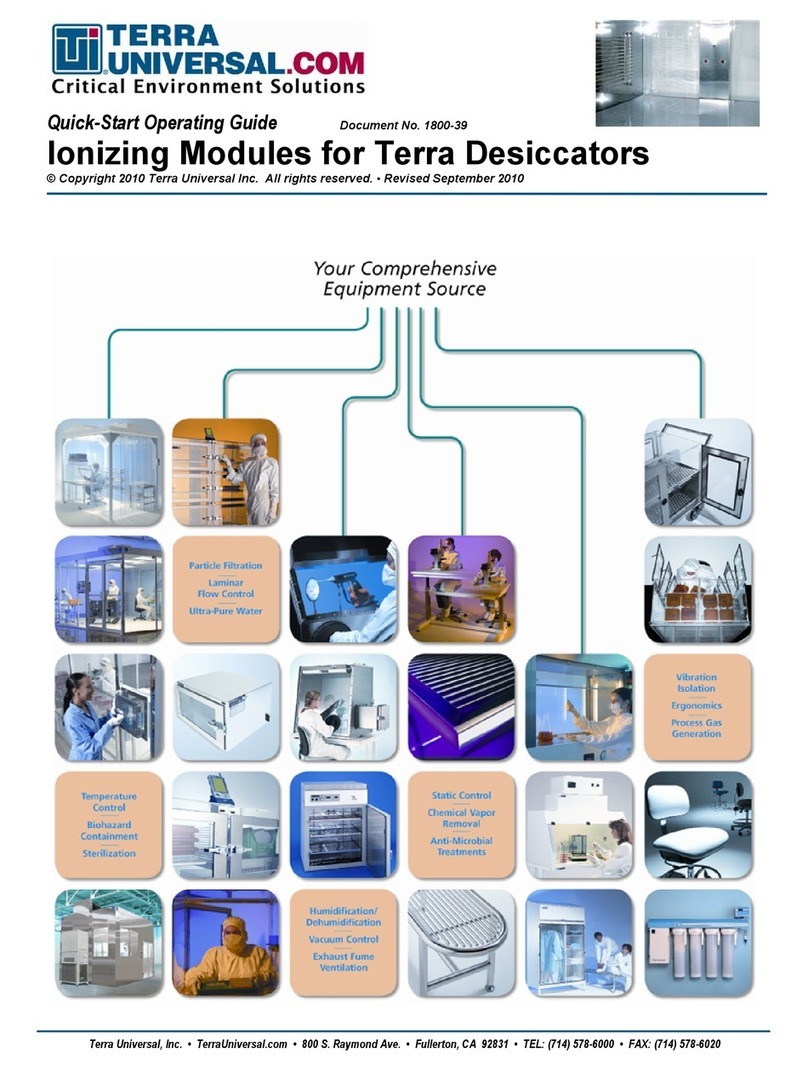
Terra Universal
Terra Universal 2006-01 QUICK START OPERATING GUIDE
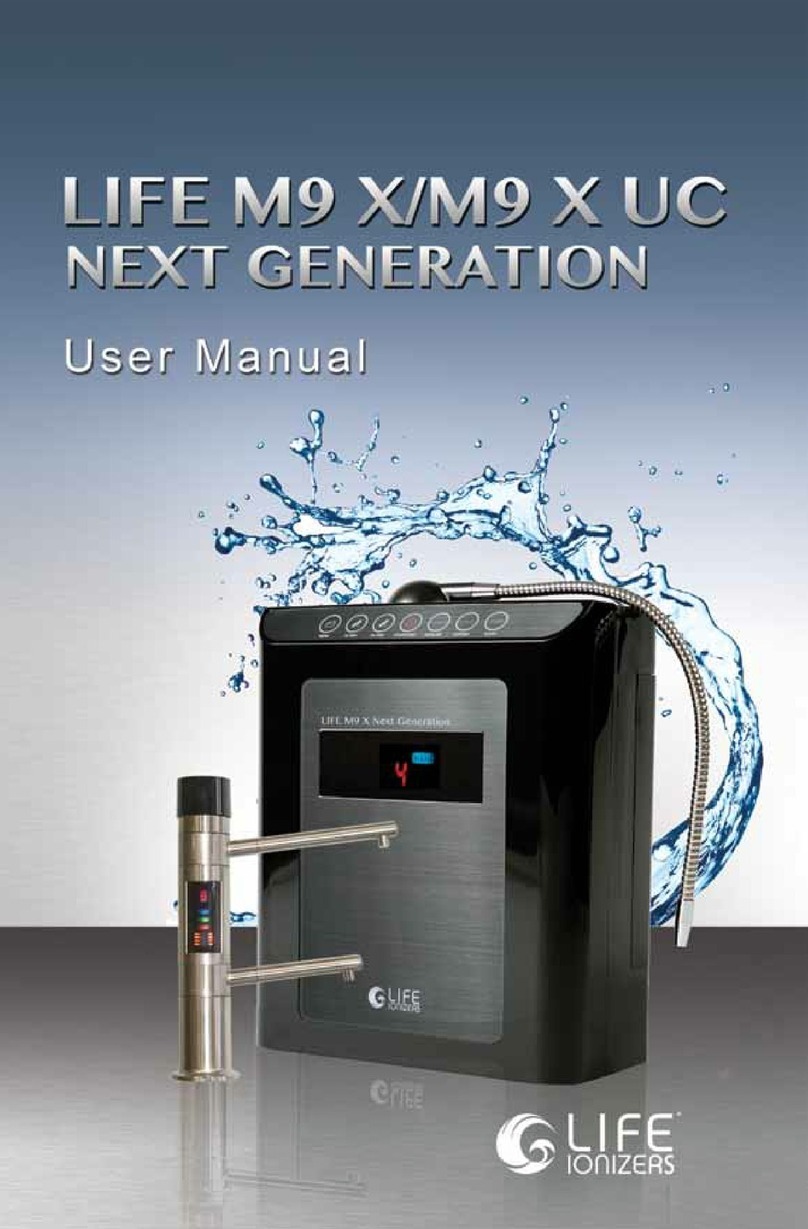
Life Ionizers
Life Ionizers M9 X NG user manual

Desco
Desco 60478 owner's manual
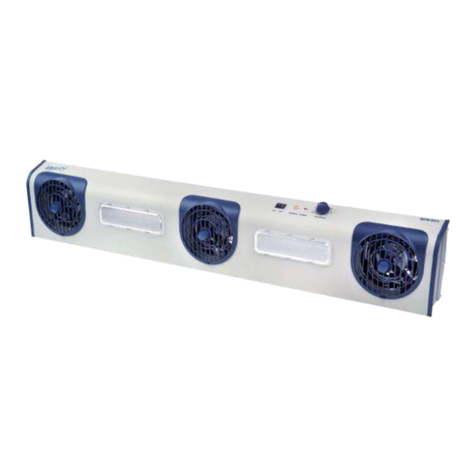
Transforming Technologies
Transforming Technologies BFN 803 instruction manual
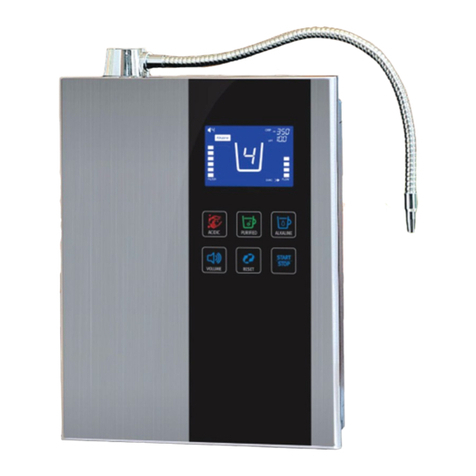
H2O LIFE SOURCE
H2O LIFE SOURCE iDUO S5 user manual

Aquavolta
Aquavolta Elegance manual
